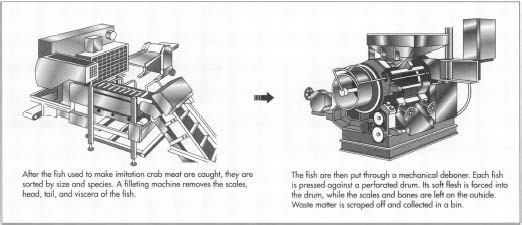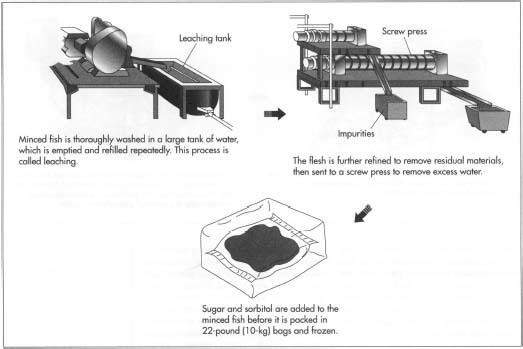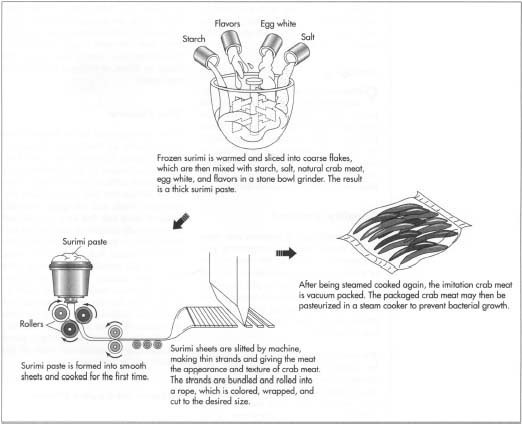Imitation Crab Meat
Background
Imitation crab meat is a seafood product made by blending processed fish, known as surimi, with various texturizing ingredients, flavorants, and colorants. First invented in the mid 1970s, imitation crab meat has become a popular food in the United States, with annual sales of over $250 million.
Surimi is the primary ingredient used to create imitation crab meat. It is mostly composed of fish myofibrillar proteins. These proteins are responsible for the quintessential characteristic of surimi that makes imitation crab meat manufacture possible, namely the ability to form a sturdy gel. The gel can be shaped and cut into thin strips which, when rolled together, mimic the texture of real crab meat.
Although imitation crab meat was introduced in the United States in the early 1980s, the Japanese have been using surimi-based products for over 800 years. Traditionally called kamaboko, the first recorded surimi manufacturing procedure was found in a Japanese cookbook written in 1528. Commercial production of kamaboko products began on a small scale in the nineteenth century. However, modern manufacturing did not start until the twentieth century, when efficient methods of bulk fishing were developed.
The basic manufacturing technology that is used today was primarily developed in Japan between 1945 and 1960. During this time, scientists developed techniques that made large-scale surimi production possible. For example, better methods of preservation were developed, and consequently the shelf life of surimi products was extended. Additionally, the science behind the gel forming properties of the myofibrillar proteins was worked out, and many factors that contributed to its texture were discovered.
One of the major problems with surimi was that when it was frozen, it lost its gel forming properties. As scientists investigated this problem, they discovered that the incorporation of cryoprotectant materials such as sucrose and sorbitol protected the surimi from degradation during freezing. This was important because it allowed imitation crab meat manufacturers to use surimi which was produced days earlier. This development of the mid 1960s resulted in a tremendous growth of the surimi-based seafood industry.
The process of making imitation crab meat from surimi was invented independently by Y. Sugino and K. Osaki by 1975. Early production of this product in the United States began in 1983 by the Japanese company Yamasa Enterprises. As popularity of this product increased, other companies also began production, and by 1986 the market for imitation crab meat was $250 million. Ultimately, U.S.-based corporations took market share away from imported products and now export imitation crab meat to Japan.
Raw Materials
Various ingredients are mixed together to make a product which has the color, taste, and texture of crab meat. The surimi used in the manufacture of imitation crab meat is most commonly processed from the Alaska pollock or walleye pollock. To a lesser extent, the New Zealand hoki is also used.

During the manufacture of surimi, various processing ingredients are added. Cryoprotectant materials such as sugar and sorbitol are added prior to freezing to prevent the degradation of the gel-forming properties of surimi. These ingredients also have an impact on the taste of the final product and help extend its shelf life.
While surimi gels provide structure, other ingredients are needed to help stabilize and modify its texture. One important ingredient is starch. It improves the texture and stabilizes the gel matrix. This is particularly important for the stability of the product when it is frozen. The amount of starch is usually about 6% of the recipe. Egg white is also added to the surimi to improve the gel structure. It has the ability to increase the gel strength and improve its appearance by making the surimi more glossy and whiter. Vegetable oil is also used to improve the appearance of surimi and modify its texture.
Flavoring is added to surimi to make it taste like crab meat. These flavorants can be natural or artificial, but typically a mixture of both is used. Natural flavoring compounds include amino acids, proteins, and organic acids, which are obtained through aqueous extraction of edible crabs. Artificial flavors can be made to closely match crab meat flavor and are typically superior to naturally derived flavorants. Artificial flavoring compounds include esters, ketones, amino acids, and other organic compounds. Additionally, seasonings and secondary flavorants are added to the meat to improve the overall flavor. Common ingredients include nucleotides, monosodium glutamate, vegetable proteins, and mirin.
The coloring for imitation crab meat is typically made using water insoluble compounds like carmine, caramel, paprika, and annato extract. By combining these and other ingredients, various shades of red, orange, and pink can be obtained. Before using the colorants, they are mixed in a surimi paste. This allows them to be easily applied to the imitation crab meat bundles.
The Manufacturing
Process
Sorting, cleaning, and filleting
-
1 The manufacture of imitation crab meat begins by preparing the fish
that will be converted to surimi. When the fish are caught in large
nets, they must be manually sorted by species and cleaned. They are
further
mechanically sorted by size to optimize the yield of fillets. Scales are mostly removed from the fish after sorting. The fish are then conveyored to a filleting machine, which removes the head, tail, and viscera. Water washing is done next to remove excess fluids. This whole process can be done either on the fishing boat or in land-based manufacturing plants.

Preparing surimi
- 2 The prepared fish fillets can then be minced, or mechanically deboned, and made into surimi. This is done using a mechanical deboner, which removes the skin, scales, fins, and bones. This machine is made up of a thick rubber belt and a perforated drum. As the fish passes through this machine, the belt presses it against the drum, forcing the soft flesh particles to the interior of the drum while leaving the harder scales and bones on the outside. The drum is constantly rotated and the excess outer material is scraped off and collected in a waste bin.
- 3 The minced fish is next thoroughly washed with water in a process called leaching. This is done in a large tank which is emptied and refilled with water repeatedly. Leaching removes many undesirable water soluble materials such as fats, inorganic salts, and some proteins. After the final leaching cycle, the mince is partially dewatered before moving to the refining phase of manufacture.
- 4 Refining machines are made up of a cylindrical screen and a rotor. The mince is selectively separated with the soft, white meat in the front of the machine and the harder, browner meat in the back. This refining step removes any residual materials such as skin, bones, and scales. The refined mince is sent to a screw press that removes all excess water.
-
5 After dewatering, cryoprotective compounds such as sugar and sorbitol
are added to the mince to help protect the fish proteins from breaking
down during the final, freezing stage of manufacture. The
final step in surimi production involves packing it in polyethylene bags in 22-pound (10-kg) blocks and quickly freezing it to below -4°F (-20°C). The surimi is stored at this temperature until it is ready to be used.

Forming the crab meat
- 6 The frozen surimi is converted to imitation crab meat through various steps. First, it is warmed to about 25°F (-4°C), then sliced into coarse flakes. In a process known as comminution, the surimi flakes are then mixed together in a stone bowl grinder with other ingredients in the crab meat recipe. These ingredients include starch, salt, natural crab meat, egg white, and flavors. This mixture results in a thick surimi paste, which is then transferred to a holding tank.
- 7 The paste is pumped from the holding tank to the sheet-forming equipment. Here, continuous sheets of surimi, about 10 inches (25 cm) wide and 0.05 inch (1.2 mm) thick are produced. Due to the chemical nature of the surimi protein, these sheets are very smooth. After the sheets are formed, they are sent to machines for the initial cooking. This cooking helps set the sheets and prepares them for the slitting operation, which gives the meat the appearance and texture of crab meat.
- 8 The slitting is done by a machine which is composed of two steel rollers that cut the surimi sheet into thin 0.1 inch (1.5 mm) wide strands. These thin strands are then bundled and rolled into a rope. This rope is given the appropriate color, wrapped, and cut to the desired size. It is then steamed cooked, forming a product that looks and tastes very much like the crab meat it is designed to imitate.
Packaging
- 9 Imitation crab meat is mechanically vacuum packed in thermoformed trays. This protects the meat from contamination and provides an appealing look. Some common plastics used for packing include polyethylene, nylon, and polyester. After packing, the imitation crab meat is typically pasteurized in a steam cooker. This step helps prevent bacterial growth and increases shelf life.
Quality Control
In the manufacture of imitation crab meat, quality control tests are performed at various points. For example, the characteristics of the incoming raw materials are analyzed. Specific properties such as pH, percentage of moisture, odor, taste, and appearance are all evaluated. The quality of the incoming fish is also checked. Most important is the test for rancidity.
The quality of the surimi is also examined by testing various characteristics. The chemical composition is tested using laboratory methods. Such things as protein content, moisture, and lipid content are all checked. Also, visual assessment of the color and texture of the surimi gives an indication of quality, as does a pH test. Since the gel-forming ability of the surimi is paramount to its use in imitation crab meat, various tests are run to ensure that it meets minimum standards before it is used. Finally, imitation crab meat is susceptible to microbial attack. Therefore, manufacturers routinely test whether their products are contaminated.
Byproducts/Waste
The water left over from the manufacture of surimi is characterized as waste water. It is composed of many water-soluble substances, fats, and suspended particles. Environmental regulations require that manufacturers treat this water before returning it to the environment. This is done using such things as filters, centrifuges, and chemical treatments.
The Future
Future developments in the imitation crab meat industry are likely to be found in a few key areas. One important area of research has focused on the development of surimi from different kinds of fish. These would include fish that currently have low economic value and are quite abundant. Many of these new fish have more fat and different body chemistries than the fish currently used, so the challenge will be to improve the surimi that can be made using them. In the manufacturing area, a more continuous process is being developed. These processes result in better yields of surimi. Also, environmental concerns will lead to new technologies that will minimize the amount of waste involved in manufacture. Finally, new crab meat recipes aimed at improving the nutritional value of the product will be developed.
Where to Learn More
Books
Lanier, Tyre, and Chong Lee, eds. Surimi Technology. Marcel Dekker, 1993.
Sikorski, Zdzislaw. Seafood Proteins. Chapman and Hall, 1994.
Periodicals
Okada, Minoru. "A fish story. What is the 'plastic food' really made of?" Chemtech, October 1991, pp. 588-591.
— Perry Romanowski
Comment about this article, ask questions, or add new information about this topic: